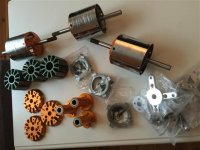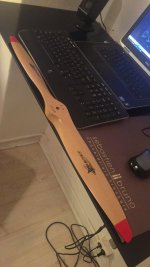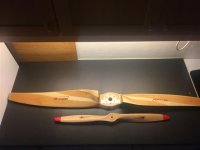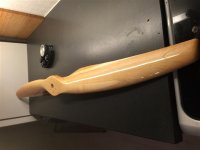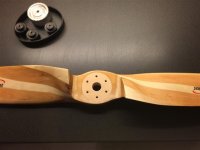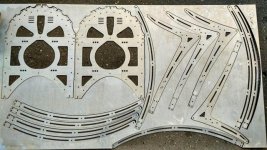Thank you for your input so far guys. I have been looking at different options and I have the numbers for one of the easier options. That is using three Turnigy 80-100 outrunners re winded with 7 turn delta, giving me a Kv of 151. With 50v and a load reduction of 0.8 that I have found to be realistic I get a loaded RPM of 6040. (50v x 0.8 x 151KV). I have been using the numbers from http://www.jobymotors.com/public/views/pages/jm1s.php to verify the thrust calculator from http://personal.osi.hu/fuzesisz/strc_eng/ and found them to correlate relatively good when using a CF of 1.25. Looking at the pictures I will get around 25kg of static thrust @ 6Kw input per motor with a 26" x 10" propeller. Three of them will give me 75kg static thrust and more in flight. That should be plenty for quick launch and climbing. That is only 18Kw from three motors, far from the 25Kw I initially aimed for, but it is the thrust numbers that is important. This require 120A per motor, something I think they handle with plenty of cooling for short spurts.
You are using an out of date browser. It may not display this or other websites correctly.
You should upgrade or use an alternative browser.
You should upgrade or use an alternative browser.
What motor would you choose for a 25kw paramotor setup
- Thread starter Ratking
- Start date
Lebowski
10 MW
If you can, don't wind in delta but in WYE. it will help your efficiency.
A bit expensive...
http://enstroj.si/Electric-products/emrax-200.html
http://enstroj.si/Electric-products/emrax-200.html
Punx0r said:Do you really need to rewind the motors? Can you not adjust the voltage or adjust the drive pulley/belt ratios? Unless of course you actually want to rewind them
I don't think I have a choice
Attachments
Lebowski said:If you can, don't wind in delta but in WYE. it will help your efficiency.
If I go for wye, the motor must be 4 turns to get 151 Kv, so much thicker phase wires.
Henri_gr said:A bit expensive...
http://enstroj.si/Electric-products/emrax-200.html
They are fantastic, but far far from my price range. One of them would do all I am asking for. I am dreaming of the prices of those motors getting realistic for DIYers
Lebowski
10 MW
Ratking said:Lebowski said:If you can, don't wind in delta but in WYE. it will help your efficiency.
If I go for wye, the motor must be 4 turns to get 151 Kv, so much thicker phase wires.
Or the same wire thickness but more strands in parallel....
Lebowski said:Ratking said:Lebowski said:If you can, don't wind in delta but in WYE. it will help your efficiency.
If I go for wye, the motor must be 4 turns to get 151 Kv, so much thicker phase wires.
Or the same wire thickness but more strands in parallel....
Of course, I would not even try to go over 1.9 mm wire ever again
But you still think that 4 turn wye is better than 7 turn delta for efficiency with the same copper fill in both cases??
Lebowski
10 MW
yes.
MrDude_1
100 kW
Ratking said:Of course, I would not even try to go over 1.9 mm wire ever againToo much hassle and sore fingers.
But you still think that 4 turn wye is better than 7 turn delta for efficiency with the same copper fill in both cases??
I can only copy what Thud told me...
a 7 turn two in hand is about the best anyone can do with these
Terminate delta=212 kv
Wye=122 kv
These 80mm motors deliver their best performance spinning about 6500-7000 rpms. Any faster & iron losses will create unbelievable heat.
Don't make the lower is better kv mistake like the guys who burn up astro's make do. They grab a low kv motor that should be running on 84v @ 50 amps peak...then feed it 48 volts @ 160amps & wonder where the smoke is coming from
If your serious about performance, get the motor spinning near its mechanical limit & gear appropriately.
I can vouch for the motor heat if you over-speed it. it gets hot fast if you go over 7000. I took mine to 9k once and it overheated in under 15 seconds of running.
I have a short update. I went for trying three turnigy 80-100 motors and will start with making a test bench where I can monitor a couple of factors that I think is important.
The following sensors are ordered:
Digital scale for measuring thrust
Termocouple for controller and motor windings
Current and voltage meter
Tacometer propeller
dB sound meter
I have bough three different propellers, 26x10, 27x10 and 28x10. With a rpm of around 5800-6000 loaded I am interested in finding out what propeller that is most suited for the job and how much thrust I can get out of the motor and propeller before the motor overheats. The motor is mounted to a frame that is pushed against a scale for those that wonders.
The following sensors are ordered:
Digital scale for measuring thrust
Termocouple for controller and motor windings
Current and voltage meter
Tacometer propeller
dB sound meter
I have bough three different propellers, 26x10, 27x10 and 28x10. With a rpm of around 5800-6000 loaded I am interested in finding out what propeller that is most suited for the job and how much thrust I can get out of the motor and propeller before the motor overheats. The motor is mounted to a frame that is pushed against a scale for those that wonders.
liveforphysics
100 TW
goa604 said:Joby jm2 perhaps. http://www.jobymotors.com/public/views/pages/products.php
That motor far exceeded my expectations on the dyno. I strongly recommend for prop drive use in its power range.
parajared
10 kW
Hey Luke, do you think that he could use a Zero Electric motorbike engine on the thing? I have seen a number of paramotors with gas motorbike engines in them.
toolbag
10 mW
- Joined
- Jun 19, 2015
- Messages
- 30
The Zero drivetrain is awesome for reliability and the fact that it exists, but it is WAY too heavy (and high power) for this. A single FX drivetrain is big even for an ultralight.
Looking forward to seeing your results! This is a project I am keenly interested in as an aviation enthusiast.
Looking forward to seeing your results! This is a project I am keenly interested in as an aviation enthusiast.
I am yet another subscriber interesting in following your path. I have been reading up on other peoples' efforts and am tempted to start my own build. It appears there are a lot of builders out there having great luck with large RC motor builds.
ecycler said:How are the tests going? Can you tell us more about the props? Wood or composite? Blades that size spinning at 6k rpms has to be a little scary up close!!
Sorry for the lack of update, the progress is as following:
I bought several smaller propellers from Hobbyking, they where 27", 28" and 29". The plan was to measure thrust with the different sizes and all other usable data. After talking with some people with more experience with propellers I was made aware that disk are of the propeller is very important for good efficiency. The problem with smaller fast spinning propellers is bad efficiency and noise. A larger diameter, large surface propeller is much better at both, so I bought a 130 cm propeller meant for a gas para motor named Moster 185. It produces 71kg thrust @ 2700 rpm. That is what I am shooting for.
I am going to wind three 80-100 for 150kv, that gives a no load speed of 7200rpm @ 48v, a voltage I think is doable loaded with a large battery(voltage loss from a 50v battery). Loaded motor is slightly slower, so I adjust with a factor of 0.8. 7200rpm*0.8/2.1 reduction gives a propeller speed of 2742 rpm. Should be right in the sweet spot for the thrust I am after. The motors will handle 150A burst with the winding scheme I have planned. That gives a theoretical output of 21600w and 60Nm to the propeller, I hope that is enough for rapid climb. Just to clarify, I will have 71kg thrust IF I get the propeller up to 2700rpm
Attachments
MrDude_1
100 kW
This is going to be awesome.
And yeah, a larger, slower spinning prop will be quieter.... Making the prop larger will make it quieter right up until you get the tips of the prop spinning near 3/4 of Mach... then they start making more noise again. Air is strange at speed.
And yeah, a larger, slower spinning prop will be quieter.... Making the prop larger will make it quieter right up until you get the tips of the prop spinning near 3/4 of Mach... then they start making more noise again. Air is strange at speed.
Thanks for the info. I have begun my ePPG build as well. Will be starting a thread soon. I already have a 130cm wooden prop for my 28hp simonini mini2 PPG. I will start my tests with that one and go from there once I get everything together. Looking forward to hearing more as you make progress. It seems you will definitely have good climbing power if you can achieve the RPM! What kind of wing are you flying with?
ron van sommeren
100 W
Sticky FAQ in the Electric Motor Design and Construction - RCG subforum:
(Re)winding and building motors, tips & tricks, checks & tests - RCG
Sticky in the Power Systems - RCG subforum:
e-flight calculators & propdata (compilation) - RCG
(Re)winding and building motors, tips & tricks, checks & tests - RCG
Sticky in the Power Systems - RCG subforum:
e-flight calculators & propdata (compilation) - RCG
Just got my package with pulleys and propeller. I choose HTD 5M 25mm since I got good experience with it from earlier projects and it is cheap for what it is.
A bit on the heavy side, but I will trim them down a lot. Gearing will be 1:2.1
As you can see, the 130cm propeller is a bit larger than the small model airplane propeller. I am looking forward to feel the thrust from the setup
A bit on the heavy side, but I will trim them down a lot. Gearing will be 1:2.1
As you can see, the 130cm propeller is a bit larger than the small model airplane propeller. I am looking forward to feel the thrust from the setup
Attachments
MrDude_1
100 kW
i see your test rig keeps the prop wash off of the motors... make sure the motors get enough airflow that they dont overheat while testing. :lol: maybe a regular AC fan plugged in behind the prop?
ecycler said:Any updates?
Hello,
Been busy with other stuff, but have not forgotten this project at all. Been talking to several experienced paramotor pilots and gathering information about what is needed.
Got input on a frame design that I really liked. Every parts is cut out of aluminum with water or laser. Just bore and thread holes and mount the frame together. Still need to design the frame for electric use and space for a battery module
Motors is still un wound, really hate the work, one error early in the wind and the whole tooth must be re-done. There is a reason for why cheap motors have bad copper fill
Attachments
MrDude_1
100 kW
Ratking said:Motors is still un wound, really hate the work, one error early in the wind and the whole tooth must be re-done. There is a reason for why cheap motors have bad copper fill
I can relate. I tore up my fingers, managed to punch myself in my face... and still didnt end up with a good motor wind. Theres very little I ever want to outsource and pay for labor on with a project, but motor winding anything except thread size wire is one of them.
Similar threads
- Replies
- 16
- Views
- 2,144
- Replies
- 329
- Views
- 180,311




